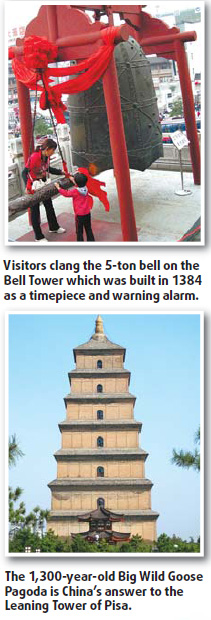|

First built in 194 BC, Xi'an's 12-m-high wall wraps 12 km around the city. [China Daily]
Armies of tourists besiege Xi'an every day to see the Terracotta Warriors. But travelers who go the extra mile to sift through the city's cultural treasure trove will discover it's a place of many hidden gems.
In AD 800, Xi'an had a population of more than 1 million and was the world's biggest city at the time. Its ancient legacy as the seat of 13 dynasties is breathing new life into its modern reincarnation. And its position as the endpoint of the ancient Silk Road has become the starting point for its modern cosmopolitan revival.
China travelers know history and modernity bump into each other in most of the country's cities. But in Xi'an, they collide, tangling together like the fenders of a time-machine pileup.

Xi'an's pulse is best felt from its heart - the town's center, which is anchored on the Bell Tower. The imposing 36-m-high tower looms over the cityscape in daytime and blazes in spotlights after sundown.
Visitors to the 1.3-sq-km structure can view historical artifacts, watch costumed chime-music performances and clang the 5-ton bell.
The tower was built in 1384 as a timepiece and warning alarm. A few minutes' walk from the Bell Tower stands its percussive counterpart.
The Drum Tower features performances and displays specimens of the 50 varieties of drums developed throughout China's history.
More than 1,000 artifacts, including furniture, shadow puppets and snuff bottles, are displayed in the two towers.
The arched passageway in the Drum Tower's base leads to Huiminjie, a street named after the predominantly Hui ethnic minority whose culture and cuisine prevail along the corridor.
This pedestrian passageway is framed by Hui eateries, where discs of naan bread and impaled gobs of mutton sizzle over charcoal grills.
Wandering west through the passageways in the surrounding Muslim Quarter - as teeming and labyrinthine as any ant farm - brings visitors to the 1,250-year-old Great Mosque.
More than 5 sq km of the 13-sq-km compound are covered with buildings, spread among four courtyards.
A newcomer to the city's tourism offerings is Qujiang Pond Monument Park, a 4.7-hectare, 2 billion-yuan ($292.7 million) site opened last July.
Visitors hop aboard small electric trains to tour eight scenic spots, including a museum showcasing relics unearthed during the park's construction, a neo-Tang Dynasty art gallery district and an ancient concert hall. Several waterfowl species flit about Bird Island, which pokes out of the 283-hectare Qujiang Pool.
But Qujiang is merely a warm-up for the other recent addition to Xi'an's travel regiment, Tang Paradise. The 1.3 billion-yuan theme park opened in 2005 and celebrates every Xi'an resident's favorite dynasty.
|

